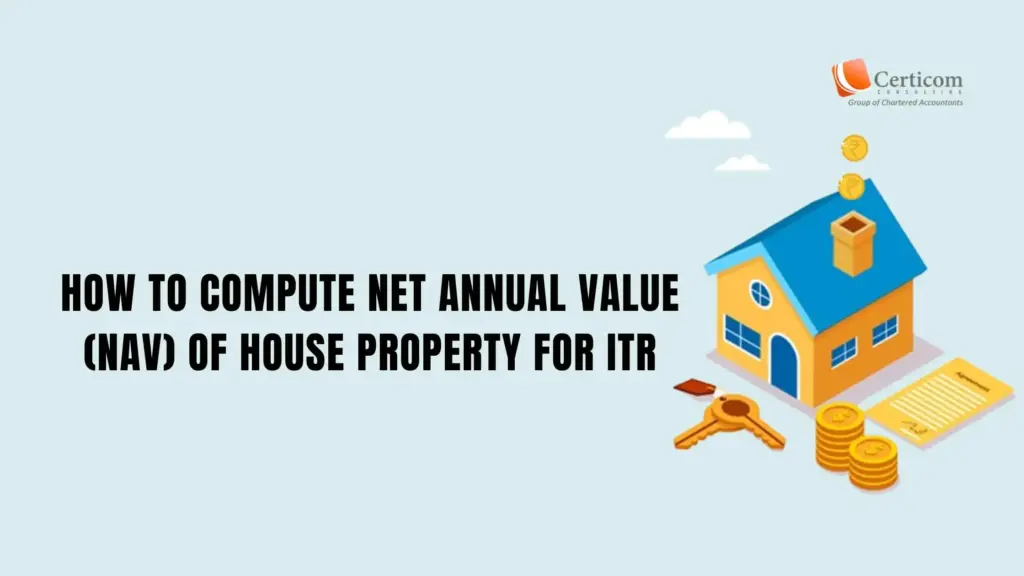HOW TO COMPUTE NET ANNUAL VALUE (NAV) OF HOUSE PROPERTY FOR ITR

It is crucial to compute the Net Annual Value (NAV) of the house of a landlord who has the income from rent. The same is on the grounds on the NAV that one could claim the qualified tax deductions. The value obtained after claiming any appropriate deductions will be the ‘income from house property’ that will be used to determine the tax obligation.
As per the laws of income tax, the NAV of the house property would be needed to get computed in two
- conditions when the house is on rent; or
- when it is assumed to be put on rent, i.e., deemed rent
Landlords need to select the ITR form based on their residency status (Resident or NRI), taxable income and type of income. For resident individuals having one house property, ITR 1 should be filed. In the case of other individuals, ITR 2 is applicable for income other than business or profession. Else, they are required to file ITR 3.

What is the Method to Compute the NAV of House Property for ITR?
For computing the NAV of the house property the initial process would be to compute the Gross Annual Value (GAV) of the same.
For computing the GAV follow the mentioned below steps
Step 1
Know the fair rent value as well as the municipal rent value. The municipal corporation will give a value to the house based on their own estimates depending on the region in which it is located. This is referred to as the house’s municipal valuation. By evaluating the rental prices of comparable homes in the same area, one may determine the reasonable rental value of a particular home. Compare the municipal rent value to the fair rent after both values are known, then choose the higher of the two.
Step 2
The next step is to compare the value generated in the first step with the standard rent (when the rent control act would apply) and choose the lower of the two values. The same value generated from the second step would known as the reasonable expected rent. Please be aware that the anticipated rent cannot be greater than the standard rate.
Step 3
The larger of the two figures should be chosen in this stage when comparing the predicted rent to the actual rent received. The GAV is the final value determined here. The GAV of the home serves as the expected rent for considered rent. This is so because no actual rent is being paid.
Permission for Rental Income Deductions
An individual is entitled to various deductions if the residence is rented or is presumed to be rented. These are the standard deduction of 30% from NAV and any house loan interest paid.
The umbrella deduction for all other home expenditures, including care, repair, and cleaning, is the standard deduction of 30% of NAV. Therefore, after this deduction, none further may be made. If a loan was used to purchase the home, the interest paid might be deducted from the NAV. To accurately determine how much of your EMI is paid for interest and to enter the proper amount in the computation, ask your lender to provide you with an annual interest certificate.
The final amount obtained after deducting the permissible expenses is known as “income from house property.” It is possible for this revenue to be positive or negative. In the event that there is a loss from housing property, the value will be negative. This loss from the house property may or may not be permitted to be offset against other sources of income such as wages, capital gains, business or profession, etc. depending on the tax regime, i.e., old or new.
Major Points to Understand About Let-out House Property
Separate calculations should be done for the multiple houses on rent- According to the tax expert “Individuals owning multiple house properties would be required to compute the income from each house property separately and accordingly claim the necessary deductions.” This implies that the standard deduction of 30% and the interest on home loans will be computed individually for each residence.
If choosing the new tax regime
If you’ve taken out a mortgage on a home that you’ve rented out, you can claim the interest you paid under section 24(b) of the new tax code. There is a limitation on the deduction, though. Only to the degree that it brings the taxable income from the home property to zero may the interest paid on the mortgage be subtracted from the rental income.

Let’s suppose that your home’s NAV is Rs. 1.2 lakh and that you have paid Rs. 1.8 lakh in interest on your mortgage. You may only deduct interest in this situation up to Rs 1.2 lakh. ‘Income from House Property’ would see a loss of Rs 60,000. Under the new tax law, this loss of Rs 60,000 cannot be claimed, set off against another loss, or carried forward.
Municipal taxes and standard deductions would be available
All regular household expenses and upkeep can be deducted up to 30% of the cost of the home. Municipal taxes that were actually paid may also be deducted for rental properties individually. Please be aware that self-occupied property cannot be used to claim these deductions.
Read More: SAFEGUARDING AGAINST FAKE INCOME TAX NOTICES
Calculating the NAV of a house property is crucial for determining income from housing property for income tax purposes. By following the method to compute the GAV and deducting relevant expenses, landlords can accurately determine their tax obligations. It is essential to understand the permissions for rental income deductions and consider the specific regulations when dealing with let-out house properties.
Related Post
Foreign Tax Credit in India: A Guide for NRIs
Top 10 Tax Filing Rules for FY 2024-25
Book A One To One Consultation Now For FREE
How can we help? *




